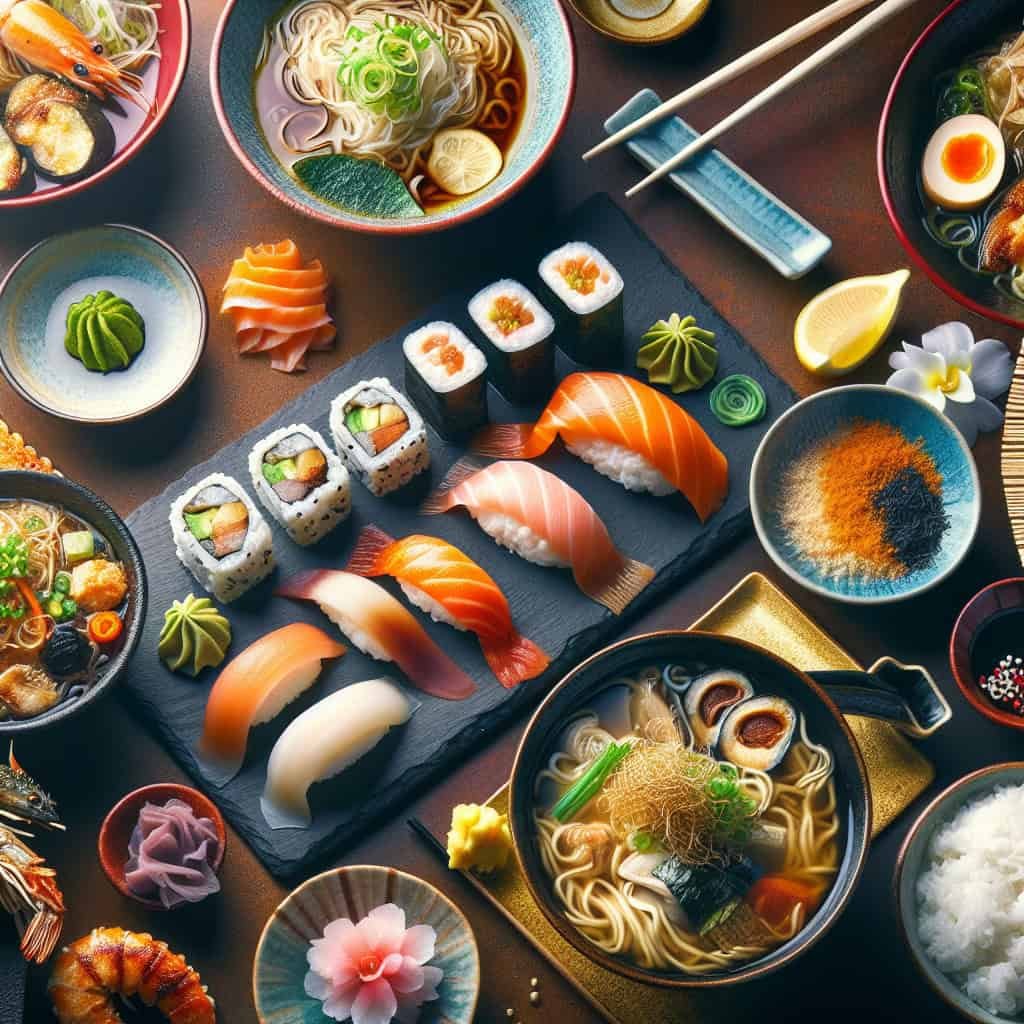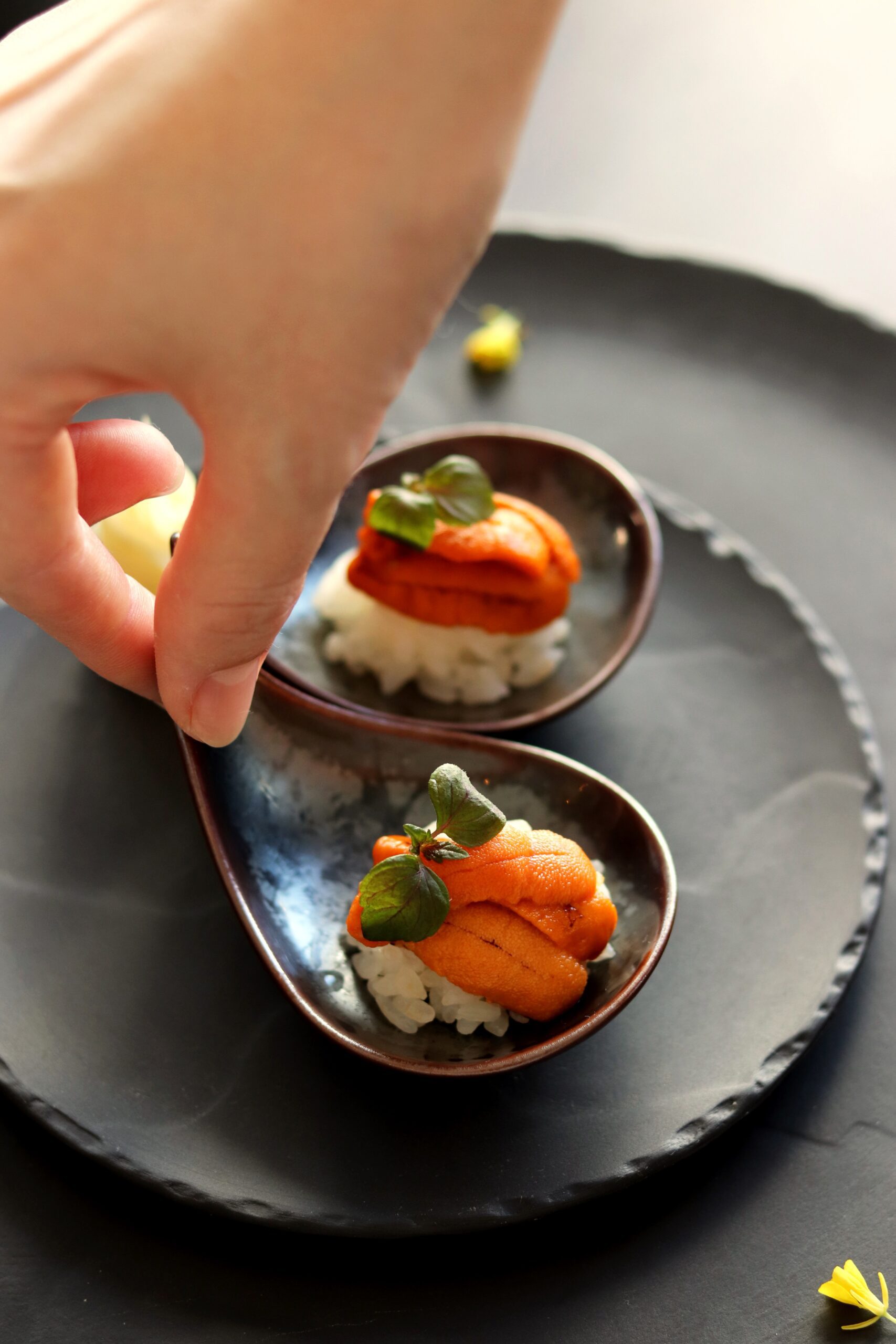Whether you’re a seasoned food enthusiast or just beginning to explore the world of Japanese cuisine, there’s no denying the allure and taste of these intriguing recipes. From the delicate balance of flavors in sushi rolls to the comforting warmth of a steaming bowl of ramen, Japanese cuisine offers a vast array of dishes that are both delicious and captivating. So, whether it’s the umami-packed flavors of miso soup or the crispy perfection of tempura, there’s no shortage of Japanese recipes that are bound to leave you craving for more.

Sushi
Sushi is a quintessential Japanese dish that has gained international popularity for its exquisite flavors and elegant presentation. When it comes to sushi, there are various types to explore, each offering a unique culinary experience.
Nigiri Sushi
Nigiri sushi is perhaps the most well-known and classic type of sushi. It consists of hand-pressed vinegared rice topped with slices of raw or cooked seafood. The simplicity of nigiri sushi allows the freshness and quality of the ingredients to shine. Whether you prefer the buttery texture of salmon, the delicate sweetness of ebi (shrimp), or the rich umami taste of tamago (egg), nigiri sushi is a delight for both the eyes and the palate.
Maki Sushi
Maki sushi, also known as rolled sushi, is a popular choice for those who enjoy a variety of flavors and textures in one bite. This type of sushi consists of rice and fillings wrapped in a sheet of nori (seaweed). The fillings can range from raw or cooked seafood to vegetables and even fruits. Maki sushi offers endless possibilities for creativity and experimentation. From the classic California roll, filled with crab, avocado, and cucumber, to the more adventurous spider roll, featuring soft-shell crab and spicy mayo, there is a maki sushi to suit every taste.
Temaki
Temaki, meaning “hand roll,” is a fun and interactive way to enjoy sushi. Unlike other types of sushi that are pre-cut into bite-sized pieces, temaki is a cone-shaped roll that you assemble yourself. The crisp nori and the combination of fresh ingredients create a burst of flavors with every bite. Whether you opt for a traditional combination of tuna, cucumber, and avocado or venture into more adventurous fillings like marinated squid and wasabi sprouts, temaki is a delightful experience that allows you to customize your sushi to your liking.
Chirashi
Chirashi, meaning “scattered sushi,” is a visually stunning dish that showcases an assortment of colorful ingredients atop a bed of sushi rice. It is often served in a bowl or a box, making it an easy and satisfying option for a meal. Chirashi typically includes a variety of sashimi, such as tuna, salmon, and yellowtail, along with thinly sliced vegetables, pickled radishes, and tamago. The combination of textures and flavors in chirashi makes it a truly satisfying and visually appealing feast for the senses.
Ramen
Ramen, a hearty and comforting noodle soup, has become a global phenomenon. Originating from China but perfected in Japan, ramen is a beloved dish that comes in a variety of styles and flavors.
Tonkotsu Ramen
Tonkotsu ramen is characterized by its rich and creamy broth, made by simmering pork bones for hours to extract maximum flavor. The resulting broth is then combined with thin noodles, tender slices of pork chashu, spring onions, and sometimes other toppings like marinated bamboo shoots and nori. The depth of flavor in tonkotsu ramen is simply unmatched, making it a popular choice for ramen enthusiasts.
Miso Ramen
Miso ramen, as the name suggests, features a broth made with fermented soybean paste, giving it a distinct savory and slightly sweet flavor. The miso broth is typically paired with curly noodles and toppings such as roasted pork, bean sprouts, and corn. The combination of the umami-rich broth and the complex flavors of miso creates a comforting and satisfying bowl of ramen.
Shoyu Ramen
Shoyu ramen, or soy sauce ramen, is a classic ramen variety that showcases the simplicity of Japanese cuisine. The broth is flavored with soy sauce, giving it a salty and savory taste. Alongside the flavorful broth, you’ll often find firm noodles, succulent chashu pork, spring onions, and nori. Shoyu ramen is a great option for those seeking a balanced and straightforward ramen experience.
Shio Ramen
Shio ramen, meaning “salt ramen,” is a delicately seasoned ramen variety that emphasizes the natural flavors of the ingredients. The broth is seasoned with salt, resulting in a light and refreshing taste. Pairing the broth with thin and chewy noodles, along with tender slices of chashu pork, bamboo shoots, and a sprinkle of nori, creates a harmonious combination of flavors in every spoonful.
Tempura
Tempura is a beloved Japanese dish consisting of lightly battered and deep-fried seafood, vegetables, or a combination of both. The delicate and crispy texture of tempura, paired with the flavors of the ingredients, makes it an incredibly satisfying and addictive dish.
Vegetable Tempura
Vegetable tempura provides a delightful way to showcase the natural sweetness and vibrant colors of various vegetables. From crisp green beans and tender eggplant to earthy mushrooms and delicate asparagus, the variety of vegetables that can be transformed into tempura is endless. The light batter and brief frying time ensure that the vegetables remain crisp and retain their distinct flavors.
Shrimp Tempura
Shrimp tempura is a classic and popular variation of tempura. The succulent and juicy shrimp are coated in a light and airy batter, creating a golden and crispy exterior. Shrimp tempura can be enjoyed as a standalone dish or as part of a larger meal, such as a tempura rice bowl or a tempura udon soup. With a drizzle of tentsuyu sauce for dipping, shrimp tempura is a delightful treat for seafood lovers.
Assorted Tempura
Assorted tempura offers the best of both worlds by combining a variety of seafood and vegetables in one dish. This allows you to experience different flavors and textures in each bite. Commonly found in Japanese tempura restaurants, the assortment may include shrimp, squid, fish, sweet potatoes, green bell peppers, and even pumpkin. Assorted tempura is a fantastic option for those who love variety and crave a well-rounded tempura experience.
Yakitori
Yakitori, meaning “grilled chicken skewers,” is a popular street food in Japan that has gained worldwide recognition for its simplicity and irresistible flavors. The smoky aroma and juicy tenderness of the skewered chicken, combined with various seasonings and sauces, make yakitori a delightful and addictive treat.
Negima Yakitori
Negima yakitori is a classic yakitori variety that pairs succulent pieces of chicken thigh with negi, or Japanese scallions. The chicken is marinated in a sweet and savory tare sauce before being skewered and grilled to perfection. The charred and slightly caramelized flavors of the meat, combined with the freshness of the scallions, create a wonderful harmony of tastes in each bite.
Tsukune Yakitori
Tsukune yakitori offers a unique twist on traditional grilled chicken skewers. Instead of using whole pieces of chicken, tsukune is made by grinding the meat with various seasonings and shaping it into bite-sized meatballs. The meatballs are then skewered and grilled, resulting in a juicy and flavorful texture. Tsukune yakitori is often glazed with a tangy and slightly sweet yakitori sauce, adding an extra layer of complexity to the dish.
Tori Tan Yakitori
Tori tan yakitori is a more adventurous and unique option for yakitori enthusiasts. It features skewered chicken liver, which is grilled to perfection while maintaining its creamy and velvety texture. Although chicken liver may not be to everyone’s taste, tori tan yakitori offers a distinct and rich flavor that is reminiscent of traditional Japanese cuisine.
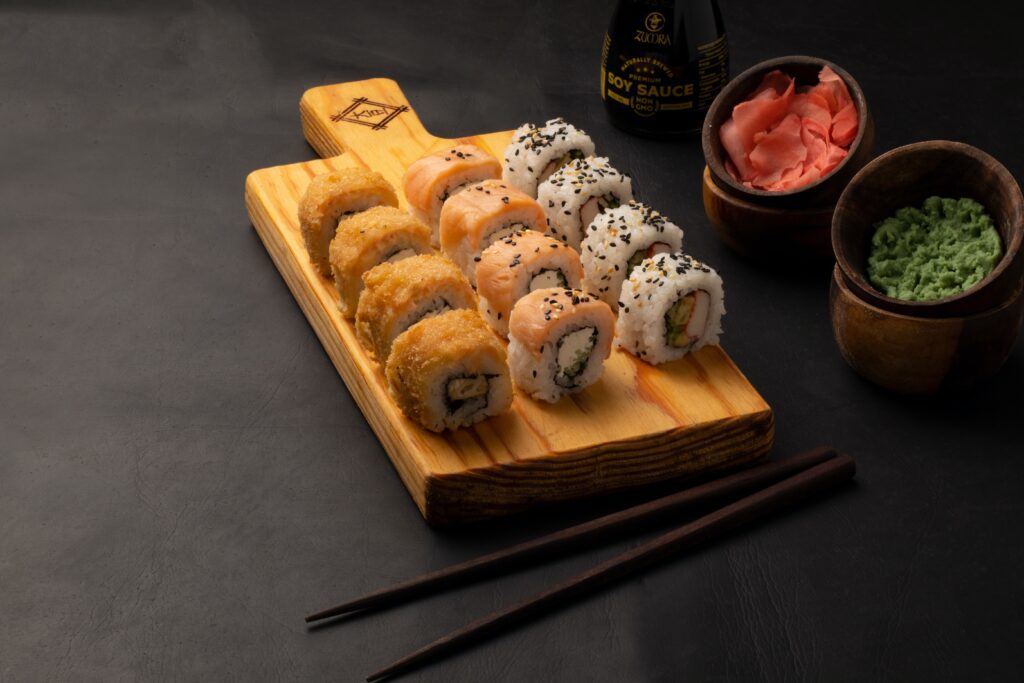
Takoyaki
Takoyaki is a beloved street food originating from Osaka, Japan. These bite-sized, spherical treats are made from a batter filled with diced octopus, green onions, and pickled ginger. Takoyaki is cooked on a special griddle, which gives them their iconic round shape and crispy exterior. Topped with a variety of sauces and garnishes, takoyaki is a popular snack that captivates both locals and visitors alike.
Classic Takoyaki
Classic takoyaki is a harmonious combination of flavors and textures. The crispy outer shell gives way to a soft and fluffy interior, with tender pieces of octopus nestled within. Topped with a drizzle of takoyaki sauce, mayonnaise, and a sprinkle of bonito flakes, classic takoyaki is a delightful explosion of umami flavors that dance on your taste buds.
Okonomiyaki-style Takoyaki
Okonomiyaki-style takoyaki takes inspiration from another beloved Japanese dish: okonomiyaki. The takoyaki batter is infused with the flavors of okonomiyaki, which typically includes elements like cabbage, tempura scraps, and Worcestershire sauce. This variation adds a unique twist to the classic takoyaki by incorporating the delicious flavors of okonomiyaki into each bite.
Cheese-filled Takoyaki
For those who enjoy a burst of gooey and creamy goodness, cheese-filled takoyaki is the perfect choice. Along with the traditional filling of octopus, a small cube of cheese is added to the center of each takoyaki ball. As the takoyaki cooks, the cheese melts, creating a velvety surprise when you bite into it. Cheese-filled takoyaki offers a delightful fusion of flavors and textures that will leave you coming back for more.
Sukiyaki
Sukiyaki is a Japanese hot pot dish that is typically enjoyed in a communal setting, making it a great meal to share with friends or family. The ingredients are cooked in a flavorful broth right at the table, allowing for an interactive and enjoyable dining experience.
Beef Sukiyaki
Beef sukiyaki is the most well-known variation of sukiyaki. Thinly sliced beef is simmered in a sweet and savory soy-based broth, along with a variety of vegetables such as tofu, mushrooms, and leafy greens. The combination of tender beef, crisp vegetables, and the rich umami flavors of the broth create a comforting and satisfying hot pot experience.
Chicken Sukiyaki
Chicken sukiyaki is a delicious alternative for those who prefer poultry over beef. Tender chicken slices are cooked in a similar manner, absorbing the flavors of the broth and vegetables. The chicken becomes incredibly tender and juicy, making each bite a delight. With the addition of mushrooms, tofu, and other vegetables, chicken sukiyaki offers a lighter yet equally enjoyable hot pot option.
Vegetarian Sukiyaki
Vegetarian sukiyaki caters to those who prefer a plant-based or meatless option. This variation features an assortment of vegetables and tofu, cooked in a flavorful vegetable-based broth. The combination of vegetables such as shiitake mushrooms, cabbage, and carrots, along with the umami-rich broth, creates a hearty and satisfying hot pot experience that celebrates the vibrant flavors of plant-based ingredients.
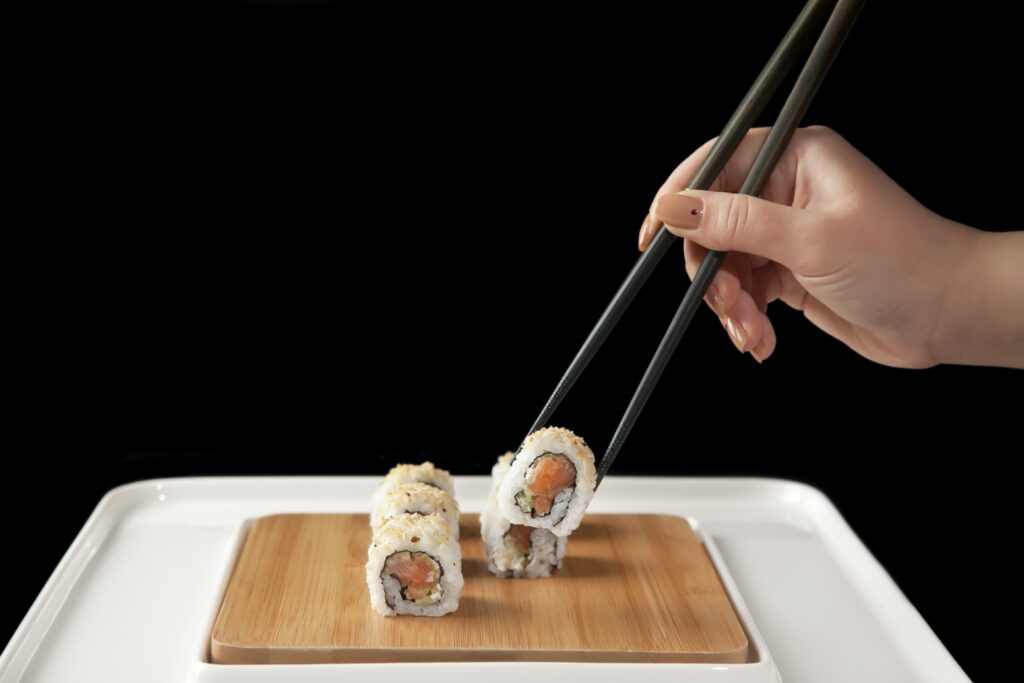
Okonomiyaki
Okonomiyaki is a savory pancake-like dish that originated in Osaka, Japan. The name translates to “grill as you like,” reflecting the customizable nature of this beloved dish. Okonomiyaki is made from a batter consisting of flour, shredded cabbage, and various fillings, which can include but are not limited to seafood, pork, or vegetables. Topped with a variety of condiments and sauces, okonomiyaki is a versatile and flavorful dish that is loved by many.
Osaka-style Okonomiyaki
Osaka-style okonomiyaki is considered the original and most iconic version of the dish. The batter is mixed with copious amounts of shredded cabbage, giving the pancake a light and fluffy texture. The fillings can vary, but common options include sliced pork, squid, shrimp, and green onions. Toppings such as okonomiyaki sauce, Japanese mayonnaise, and bonito flakes add the finishing touches, creating a harmonious blend of flavors and textures.
Hiroshima-style Okonomiyaki
Hiroshima-style okonomiyaki is a unique variation that features layers of ingredients, resulting in a truly hearty and substantial meal. The batter is spread thin on the griddle, followed by a layer of cabbage, bean sprouts, and optional additional ingredients such as sliced pork or yakisoba noodles. The batter is then poured over the layers, creating a stack of flavors that meld together as it cooks. Toppings such as okonomiyaki sauce, Japanese mayonnaise, and a fried egg complete this indulgent dish.
Negiyaki
Negiyaki is a simplified version of okonomiyaki, focusing on the flavors of green onions, or negi. The batter is mixed with generous amounts of finely chopped negi, giving the pancake a distinct and vibrant taste. While negiyaki can be enjoyed as is, it is often paired with a variety of toppings such as okonomiyaki sauce, beni shoga (pickled ginger), and aonori (dried seaweed flakes). Negiyaki is a refreshing and light option for those looking for a different take on the classic okonomiyaki.
Kaiseki
Kaiseki is a traditional Japanese multi-course meal that originated from the tea ceremony. It is a culinary art form that showcases the harmony between seasonal ingredients, flavors, textures, and presentation. Each course is thoughtfully designed to create a symphony of tastes that elevate the dining experience.
Ichiju Sansai
Ichiju sansai, meaning “one soup, three dishes,” forms the backbone of a kaiseki meal. This course typically consists of a clear soup, a sashimi dish, a simmered dish, and a grilled dish. The components are carefully selected to provide a balance of flavors and textures. The clear soup cleanses the palate, the sashimi showcases the freshness of the seafood, the simmered dish highlights the delicate flavors of vegetables and proteins, and the grilled dish adds a smoky and savory element.
Hassun
Hassun is an artistic course that showcases the seasonal beauty of Japan. It typically includes an assortment of small dishes, presented in an aesthetically pleasing manner. The dishes may feature seasonal ingredients, such as bamboo shoots in spring or chestnuts in autumn. The presentation often incorporates elements of nature, such as leaves or flowers, creating a visual representation of the changing seasons.
Yakimono
Yakimono refers to grilled dishes, which are an integral part of a kaiseki meal. Grilling techniques are used to enhance the flavors of ingredients such as fish, poultry, or vegetables. The smoky and charred notes imparted by grilling add depth to the dishes, creating a delightful contrast of textures and flavors.
Suimono
Suimono, meaning “clear soup,” is a light and refreshing course served during a kaiseki meal. The soup is typically made from kombu (kelp) or dashi (a stock made from bonito flakes) and is delicately seasoned to allow the natural flavors of the ingredients to shine. Common additions to suimono include tofu, seasonal vegetables, and perhaps a sprinkle of yuzu zest to provide a citrusy aroma.
Mizumono
Mizumono, the final course of a kaiseki meal, consists of a sweet or dessert. Traditionally, mizumono is a light and delicate offering, often featuring fruits, jellies, or Japanese sweets known as wagashi. The sweetness of mizumono provides a satisfying end to the meal and symbolizes the completion of the kaiseki experience.
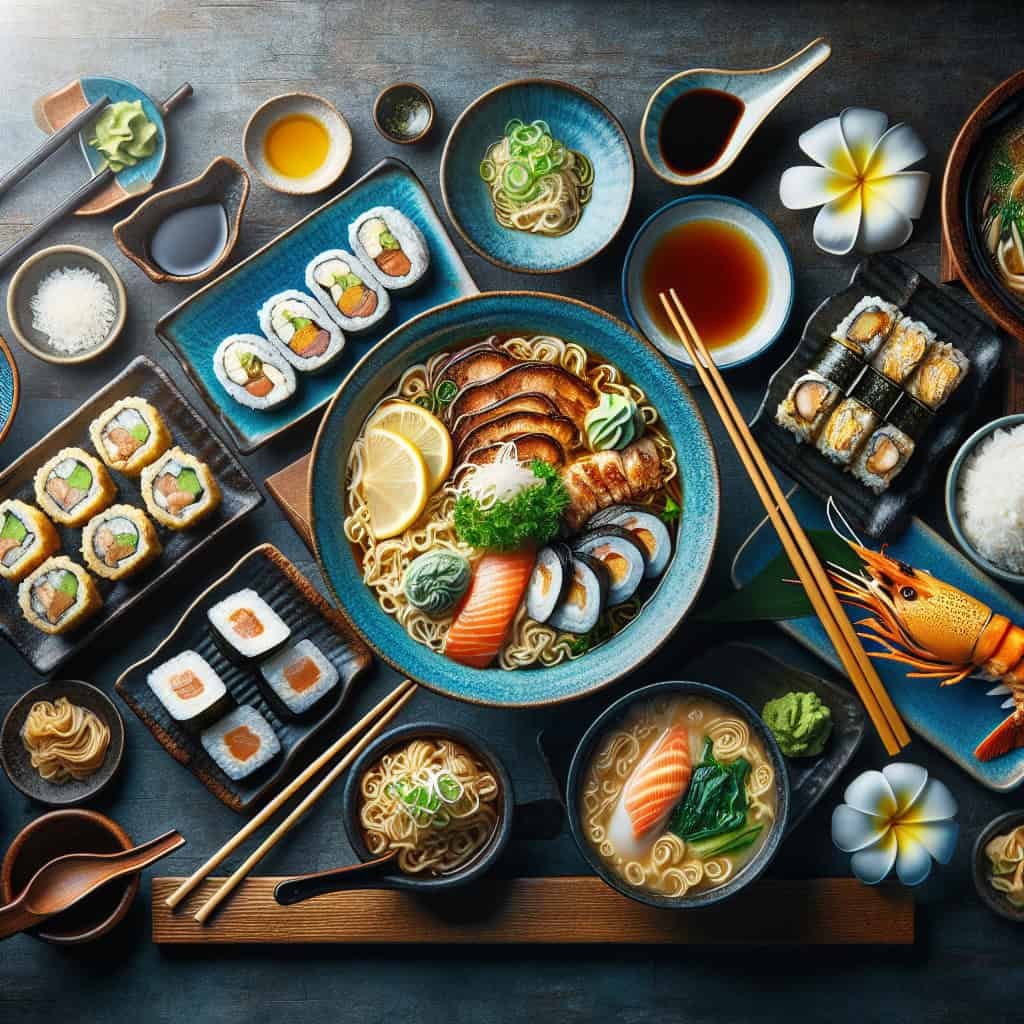
Udon
Udon is a type of thick wheat noodle that is widely enjoyed in Japanese cuisine. The noodles are known for their chewy texture and ability to absorb the flavors of the broth they are served in. Udon can be enjoyed in a variety of ways, making it a versatile and comforting dish.
Kake Udon
Kake udon is a simple yet delicious way to enjoy udon noodles. The noodles are served in a hot and flavorful broth made from dashi, soy sauce, and mirin. Toppings such as thinly sliced green onions or tempura flakes can be added to enhance the flavors. Kake udon is a popular choice for those seeking a comforting and satisfying noodle dish.
Tempura Udon
Tempura udon combines the best of both worlds by pairing the chewy udon noodles with crispy tempura. The noodles are served in a hot broth, often made from dashi, soy sauce, and mirin. The tempura, which can include shrimp, vegetables, or a combination of both, adds a delightful contrast in textures. Tempura udon is a satisfying and flavorful dish that is widely enjoyed in Japan.
Zaru Udon
Zaru udon is a refreshing and chilled variation of udon that is particularly popular in the summer months. After the udon noodles are cooked, they are cooled down and served on a bamboo mat called a zaru. The noodles are usually accompanied by a dipping sauce made from soy sauce, mirin, and dashi. Toppings such as thinly sliced green onions, grated ginger, or grated daikon radish can be added for additional flavor. Zaru udon is a light and refreshing dish that is perfect for hot weather.
Sashimi
Sashimi is a beloved Japanese dish that showcases the pure flavors and textures of raw seafood. It is often served as an appetizer or as part of a larger meal, allowing diners to savor the freshness and delicate tastes of the ingredients.
Maguro (Tuna) Sashimi
Maguro sashimi is a classic and well-loved choice for sashimi enthusiasts. The deep red color and buttery texture of fresh tuna create a melt-in-your-mouth experience. Whether enjoyed on its own or dipped in soy sauce and complemented with wasabi and grated ginger, maguro sashimi is a flavorful and enticing delicacy.
Sake (Salmon) Sashimi
Sake sashimi, also known as salmon sashimi, is another popular variety of sashimi. The vibrant orange color and rich, fatty texture of fresh salmon make it a delightful treat for seafood lovers. The delicate flavors of salmon can be enhanced with a squeeze of lemon juice or by pairing it with a dab of wasabi and soy sauce. Sake sashimi is a versatile and delicious option that is often enjoyed in various Japanese dishes.
Tai (Sea Bream) Sashimi
Tai sashimi, made from the sea bream fish, offers a delicate and slightly sweet flavor. The white flesh has a firm yet tender texture that is highly regarded in Japanese cuisine. Tai sashimi is often prized for its mild taste and is sometimes served as a symbol of celebration during special occasions. The simplicity of enjoying tai sashimi allows the natural flavors of the fish to shine through, creating a truly delightful experience.
